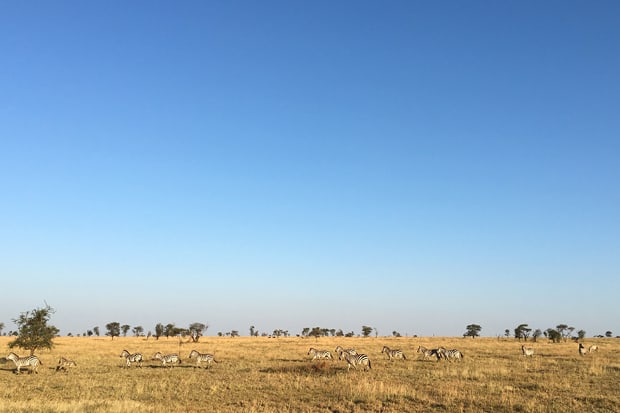Join/
Just Back From
Just Back From...Tanzania
The Serengeti, that vast national park in northern Tanzania that runs seamlessly into Kenya’s Maasai Mara, turns everyone into a ravenous beast. The minute you arrive, you feel starved for those expansive landscapes, all rolling bruised clouds and seemingly endless plains. You long to drive in a fast Jeep, tasting the wind and the dust, gulping down the pungent scents, searing impressions of this beautiful, big world into the back of your eyelids.
Throughout its history, East Africa’s wilderness has drawn a diverse cast of characters, from colonialists, opportunists and hunters to writers, philanthropists and conservationists. The work of the latter has been especially prevalent in Tanzania, a country the size of Germany and France combined that has designated nearly 25 percent of its land as protected areas. The Serengeti, Tanzania’s oldest national park, encompasses nearly 6,000 square miles and boasts the highest concentration of large mammals roaming freely in one of Earth’s oldest ecosystems. Its plains and savannahs, studded with acacia trees, smooth kopje rock formations and seas of tall grass, are iconic—they are what most associate with a safari (the vegetation of South Africa’s Kruger National Park, for example, is much more forested).
What a privilege it is then to go to wake up surrounded by this miracle of nature, in midst of abundant wildlife, ranging from the tiniest painted birds to herds of African elephants. Thanks to decades of thoughtful development, the park today offers lots of different accommodations: there are authentic hunting camps-turned small lodges with just a handful of rooms; over-the-top camps decked out in baronial splendor; and lavish tents with plush beds under canvas. You can stay in the bush like Hemingway did, with “the discomforts that you paid to make it real” (his words) or you can opt for tents with designer interiors.
Since 2013, there is also a more sizeable hotel, the Four Seasons Serengeti Lodge, which sits in an enviable location in the very center of the park and presents a great option for families, groups of friends and anyone craving resort amenities in the bush. The 77-room property has a large pool, a spa on stilts and a gym for those craving exercise in between game driving and eating (safaris’ main activities). It also has a dedicated kids’ club and accepts children of all ages, which most bush lodges do not. Rooms are spacious and almost all come with expansive views across the Serengeti, and the main pool overlooks a watering hole where you may spot elephants, zebras, wildebeest and others throughout the day. (Read a full review of the property here.)
Related: Tanzania Destination Guide
Today’s luxury safari experience involves an absurd amount of pampering—is there anything more decadent than sipping pink Champagne during a bush sundowner? But the extraordinary point of visiting here is getting to experience a completely wild place and feeling your soul expand as you connect with it. How humbling to watch thousands of grunting, big-headed wildebeest galloping by your safari Jeep, in the ever-repeating journey known as the Great Migration. How deeply thrilling to spot a leopard entangled in an almost sensual way with a fresh impala kill in the fork of an acacia tree. How moving to watch a family of elephants feasting on bramble together and then slowly meandering into the hazy distance, like sleepwalkers following a call only they can hear.
The conservation of this ecosystem has been—and remains—the work of incredibly passionate men and women who often put their own lives at risk to protect the wild. Poaching in the Serengeti has decreased, but certain animal populations remain dangerously low, like the black rhino of which there are only around thirty left in this national park. Since there are no fences around any of Tanzania’s national parks, a huge focus is on sustainable solutions for human-wildlife interaction.
Related: Families on Safari
“There are some 900,000 people living in the Serengeti ecosystem and that population will continue to grow,” says Dennis Rentsch, the Serengeti-based manager of the acclaimed Frankfurt Zoological Society, which was founded by legendary German conservationist Bernhard Grzimek and that has two outposts in the park. “It doesn’t make sense to only look at it through a prism of protecting wildlife. It’s crucial to work directly with the local people so that they see the value in conservation and also share in the profits that tourism brings here.”
And conserve these ecosystems we must, because losing them would mean losing something crucial to humankind. There’s an ancient force at work in the east African bush, highlighting your own insignificance but also urging how precious your time here is. This is why you yearn to devour it all: not in polite nibbles but savagely, like a lion tearing into the hide of a zebra, ripping through skin and flesh, crunching the bones.
Related: Tanzania Packing Guide

And yet, the greatest gift of transformation is the fact that once you’ve seen, smelled and tasted the Serengeti, you understand instinctively that it’s been inside of you all along, lying in wait beneath an audacious sky—ferocious, wild and free.
For help planning a trip to Tanzania, including a safari in the Serengeti, contact Indagare's Bookings Team.
Plan Your Trip With Us
We only feature hotels that we can vouch for first-hand. At many of them, Indagare members receive special amenities.
Get In Touch


